Fig. 34.1
Superficial infiltration of lidocaine-adrenaline under the planned skin incisions. Tip of the steel cannula can be seen right under the skin.
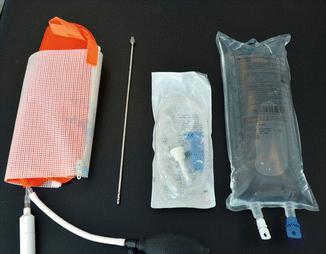
Fig. 34.2
Simple set for lidocaine-adrenaline infiltration: pressure bag, 3.5 mm cannula, i.v. tubing, and 1000 mL saline with lidocaine-adrenaline for infiltration
The more convenient, more effective, and a faster method is to use Body-JetR (Human Med, Schwerin, Germany) for infiltration. With Body-Jet, saline is infiltrated with higher pressure (up to 110 bar) causing more effective and more immediate vasoconstriction (Fig. 34.3).
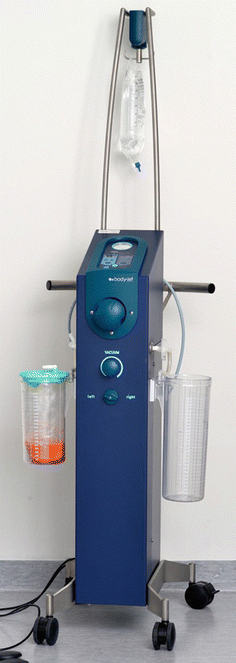

Fig. 34.3
Water-assisted liposuction and infiltration with Body-JetR makes infiltration faster and facilitates vasoconstriction. We can use pulsating water pressure up to 110 bar to facilitate vasoconstriction. Tubing is for single use and cannot be sterilized
Skin incision is made with scalpel, and thereafter, dissection is continued with electrocautery meticulously coagulating all visible vessels. Because of vasoconstriction, vessels are easily identified and coagulated (Fig. 34.4). After dissecting and discarding the lower flap, an upper flap is formed from the umbilicus up to the xiphoideus to expose abdominal rectus muscles and the muscle sheet. The distal edge of the upper flap is thinned from deep fat with electrocautery along the fascia of Scarpa.
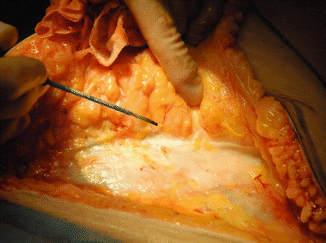

Fig. 34.4
After infiltration and vasoconstriction, vessels are easily identified and cauterized. Note the overall lack of bleeding and clean operating field
All women who have had pregnancy seem to have diastasis of the rectus abdominis muscles varying from a few centimeters up to 6–7 cm. Muscles are plicated from the pubis to the xiphoid using nonabsorbable, multifilament, inverted 0 (SurgileneR or MersileneR) X knots bringing the edges of the muscles to each other. The second layer of sutures is started from the xiphoideus all the way down to the pubis using continuous, absorbable, monofilament 0 (PDSR) loop. This suture covers and hides the knots of the previous layer and further tightens the horizontal width of the abdomen. It also shortens vertical length of the rectus sheet.
To close the space between the fat and muscle fascia, we use absorbable multifilament thread (2-0 VicrylR) as tension sutures (Fig. 34.5). First sutures are placed in the midline below the xiphoideus and are continued down to the umbilicus. On the lateral sides (flanks), tissue is pulled toward the midline to avoid lateral dog ears. After suturing the upper half of the abdomen down to the umbilicus, a hole is made with scalpel in the midline for the umbilicus. Incision is 1 × 1 cm, the caudal part of the incision being an inverted V-flap to match the incision made in the umbilicus (Fig. 34.6), which is pulled through the hole with a Crile. Care must be taken to keep the umbilicus in the midline. Thereafter, tension sutures are placed on the lower half of the abdominal wall with 2–3 cm intervals. Skin edges are pulled together with 2-0 absorbable sutures (VicrylR). Skin is closed with continuous intracutaneous 3-0 absorbable monofilament thread (MonocrylR). No suction drains are used.
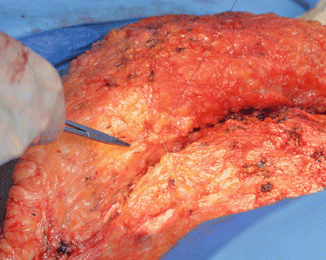
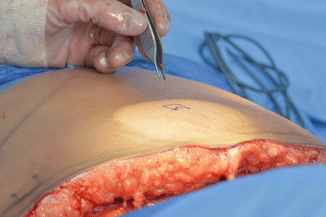

Fig. 34.5
Tension sutures are placed between the deep fat and the muscle fascia with 2–3 cm intervals. The number of the sutures depends on the size of the patient or rather the size of the area that has to be closed

Fig. 34.6
Skin markings for the umbilicus. Note inverted V-flap on the caudal part to avoid circumferential and unfavorable scaring
Skin incision is covered with paper tape (MicroporeR), and preordered custom-made textile garment or elastic belt is put on the operating table. Patients are recommended to wear elastic garment for a minimum of 3–4 weeks, but most patients get used to them and have them 2–3 months postoperatively (which can be inconvenient in hot climate).
Patients are mobilized as soon as they recover from the anesthesia and are able to stand. No bedpan or urinary catheter is used. All patients are discharged the same evening or not later than the next morning and have appointment with the operating surgeon a month and 6 months after surgery. No heavy lifts (>10 kg) are recommended for the next 4 weeks after surgery.
Pain after abdominoplasty can be significant. However, the author tries to avoid opioids to be able to mobilize patients as soon as possible. Patients are discharged with oral medication (combination of Panadol 500 mg and codeine 30 mg tablets: 1–2 tablets three or four times daily as needed and ibuprofen 600 mg four times daily).
This technique has been used with over 350 patients. First 95 patients were analyzed and published [25]. In the study, 60 patients had additional operations with abdominoplasty: 49 had liposuction of both flanks (100–350 mL fat/flank). First 12 patients had drains, but since then, drains were abandoned because of no or minimal discharge. Mean age of the patients in the study was 43 years and BMI 27.1 (range 19–39). Operative data is shown on Table 34.1. Results of abdominoplasties are shown in Figs 34.7 and 34.8. The technique is suitable also for obese patients; we have used it with success to patients weighting over 140 kg and removal of fat over 9 kg.
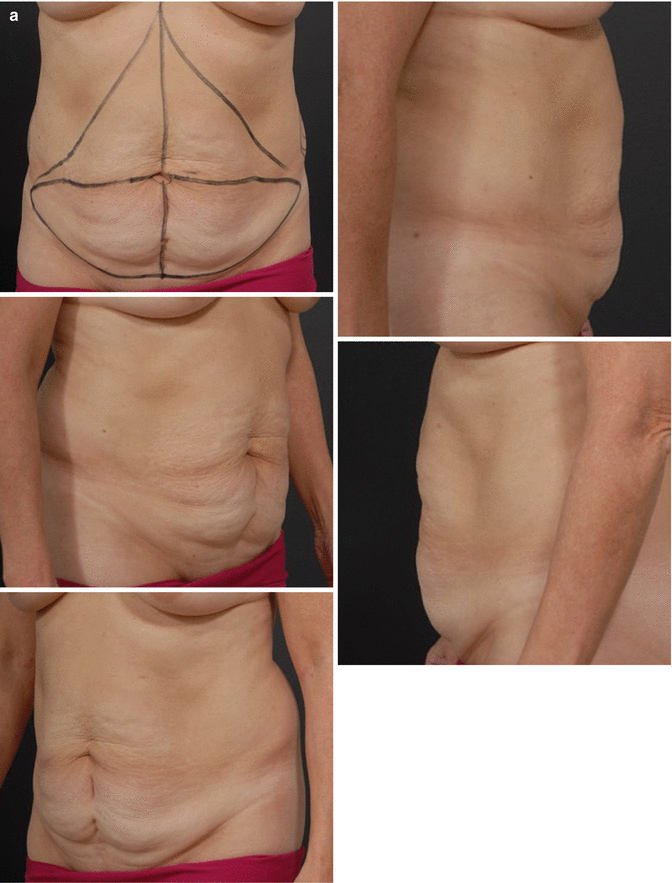
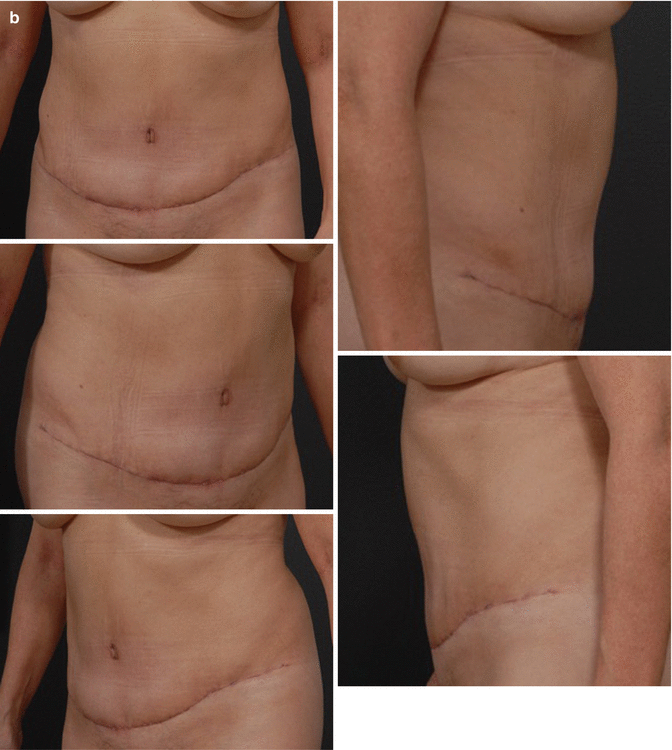

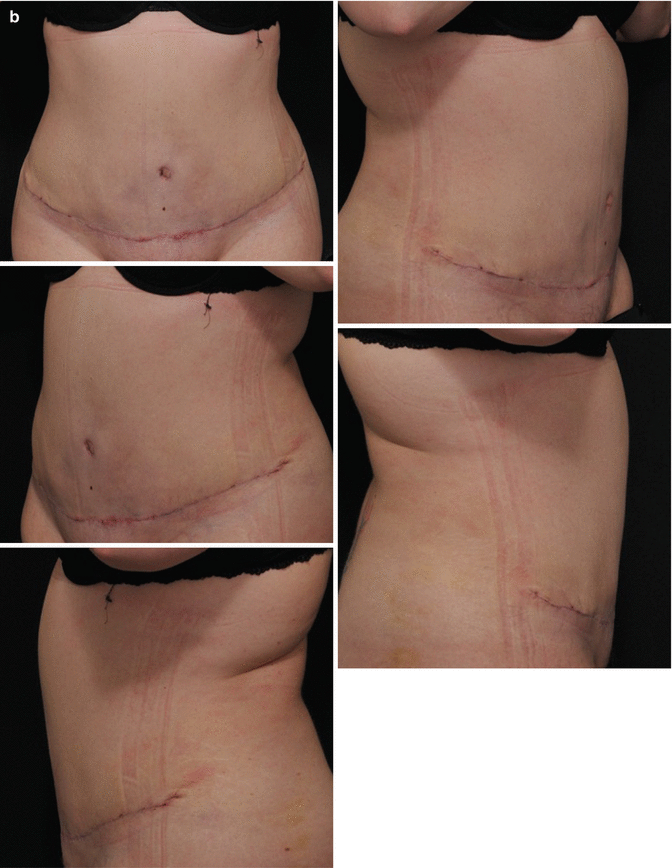
Table 34.1
Operative data
No. | Mean | Min. | Max. | SD | |
|---|---|---|---|---|---|
Operating time (min) | 93 | 82 | 45 | 173 | 28 |
Perioperative bleeding (ml) | 95 | 233 | 20 | 1100 | 204 |
Weight of removed mass (g) | 94 | 1422 | 135 | 6824 | 1009 |
Fat removed in liposuction (ml) | 49 | 576 | 200 | 1400 | 245 |


Fig. 34.7
(a) Preoperative. (b) Four weeks after abdominoplasty


Fig. 34.8
(a) Preoperative markings. (b) Four weeks after abdominoplasty
In the first 95 cases, abdominoplasty as the only operation took a mean of 65 min. Mean perioperative bleeding with only abdominoplasty was significantly less compared with abdominoplasty combined with other operations. There were no major complications (pulmonary embolism, deep venous thrombosis or flap necrosis, or dehiscence). The incidence of minor – not clinically significant – complications was 12.6 %: two small seromas and three small hematomas not requiring aspiration, one local wound infection, one small necrosis of the wound edge, and three small fistulas made by the multifilament subcutaneous thread. All were treated conservatively.








